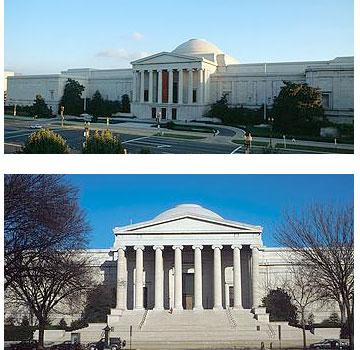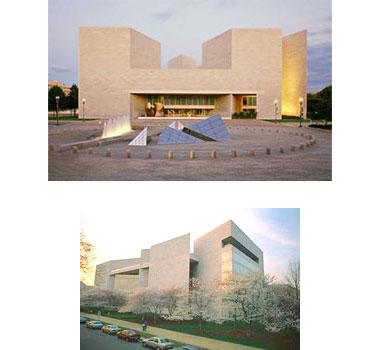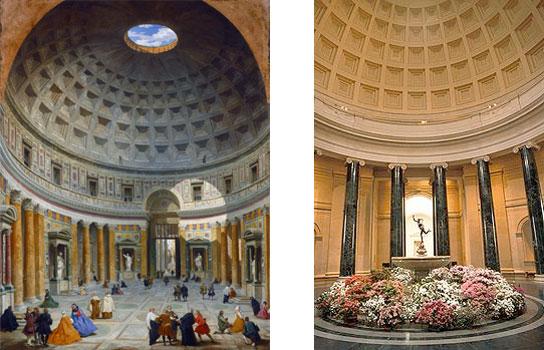Students will compare and contrast design elements in neoclassical and modern architecture, using the National Gallery of Art’s West and East Buildings. Then they will design a geometric pattern using Pei's polygons. Last, they will consider the role of geometry in planning and designing buildings and cities by creating their own city plan using a variety of lines and polygons.
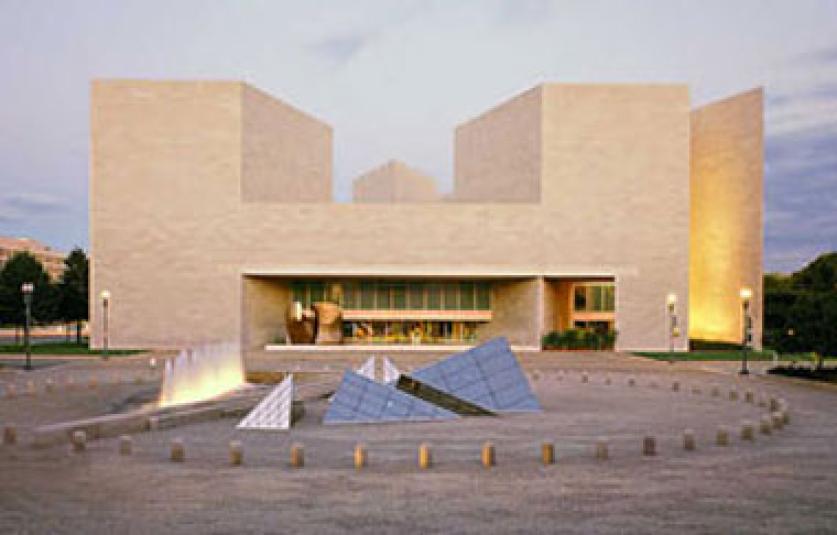
I. M. Pei
Chinese American, born 1917
East Building, 4th Street façade
Photograph: © Dennis Brack/Black Star
Language
NAEA Standards
| 2-A | Students generalize about the effects of visual structures and functions and reflect upon these effects in their own work. |
| 3-A | Students integrate visual, spatial, and temporal concepts with content to communicate intended meaning in their artworks. |
| 4-B | Students describe and place a variety of art objects in historical and cultural contexts. |
| 4-C | Students analyze, describe, and demonstrate how factors of time and place (such as climate, resources, ideas, and technology) influence visual characteristics that give meaning and value to a work of art. |
| 5-B | Students analyze contemporary and historic meanings in specific artworks through cultural and aesthetic inquiry. |
| 6-A | Students compare the characteristics of works in two or more art forms that share similar subject matter, historical periods, or cultural context. |
| 6-B | Students describe ways in which the principles and subject matter of other disciplines taught in the school are interrelated with the visual arts. |
Materials
- Smart Board or computer with ability to project images from slideshow
- Graph paper
- Markers
- Colored pencils
- Graphite pencils
- Street maps or plans of your city or town
- Copies of “Pei’s Polygons” worksheet
Warm-Up Question
What geometric shapes do you see in this building?

I. M. Pei at the National Gallery of Art
© Dennis Brack/Black Star
National Gallery of Art, Gallery Archives
Background
I. M. Pei was born in 1917 in Canton (now Guangzhou), China, to a family of wealthy landowners. I. M. stands for Ieoh Ming, which means "to inscribe brightly." Pei can trace his family back more than six hundred years to the Ming Dynasty.
Pei was exposed to both Eastern and Western values from an early age. His father was a successful banker. The family lived in the modern cities of Hong Kong and Shanghai, where Pei saw skyscrapers being built. He accompanied his mother on Buddhist retreats, learning to meditate in silence. She died when Pei was 13 years old. Soon after, he and his four siblings went to live with family caretakers.
Pei fondly remembers watching American movies that introduced him to the easy-going American lifestyle. He also liked playing billiards and later realized it helped him understand geometry. He completed high school in Shanghai, and at age 17, he sailed for America to study architecture at MIT. After graduating in 1940, he went on to graduate school at Harvard University to study the emotional and rational sides of design under Walter Gropius and Marcel Breuer.
By 1955, Pei had become an American citizen and founded his own architecture firm. He went on to create dramatic buildings known for their angular geometry, expansive glass and concrete walls, spacious indoor atriums, and space-frame skylights. One of his most famous commissions was the National Gallery of Art’s East Building to house its modern and contemporary art collection and temporary exhibitions.
Guided Practice
The National Gallery of Art opened in 1941. By the 1960s, it needed more space for its growing collections. The original building, designed by architect John Russell Pope in the 1930s, was built on a spacious rectangular tract of land along the National Mall in Washington D.C.
Have students consider the following questions as they view the slideshow below to help them uncover the plan for the East Building and how Pei balanced it with the existing West Building and the collections it would hold:
- How are the two buildings different in design?
- Do you see a difference in the approach of the two architects?
- Do you think the types of art housed in each building influenced its design?
Slideshow: East Versus West: The Buildings of the National Gallery of Art
Examine the architectural details from the National Gallery of Art below. Can you tell which building—West (neoclassical) or East (modern)—each detail is from?
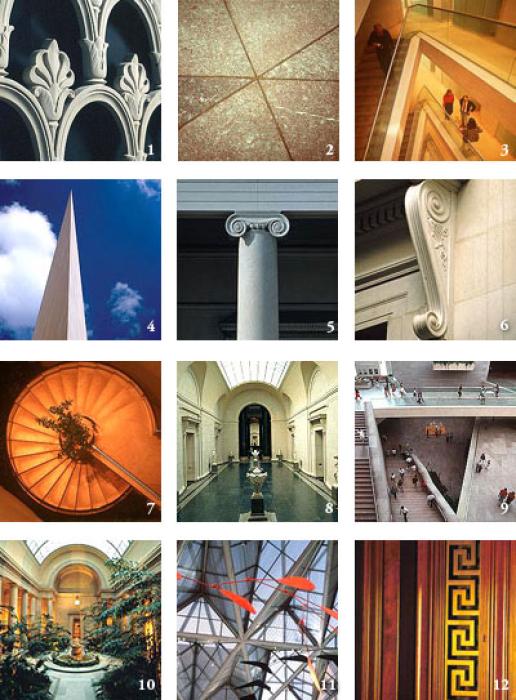
All photographs: © Dennis Brack/Black Star
National Gallery of Art, Gallery Archives
Answers: 1. West Building Detail, 2. East Building Marble Floor, 3. East Building Study Center, 4. East Building Knife Edge, 5. West Building Columns, 6. West Building Detail, 7. East Building Spiral Staircase, 8. West Building Sculpture Hall, 9. East Building Atrium, 10. West Building Garden Court, 11. East Building Space Frame with Calder Mobile, 12. West Building Detail
Answers: 1. West Building Detail, 2. East Building Marble Floor, 3. East Building Study Center, 4. East Building Knife Edge, 5. West Building Columns, 6. West Building Detail, 7. East Building Spiral Staircase, 8. West Building Sculpture Hall, 9. East Building Atrium, 10. West Building Garden Court, 11. East Building Space Frame with Calder Mobile, 12. West Building Detail
Pei designed the East Building in the 1970s. Some scholars said Pei was influenced by minimalist artists of the 1960s who used geometric shapes and industrial materials to create simple, unemotional forms. But Pei's first challenge for the East Building was the odd-shaped parcel of land it was to be built on.
Here's a street map that shows the National Gallery of Art buildings:
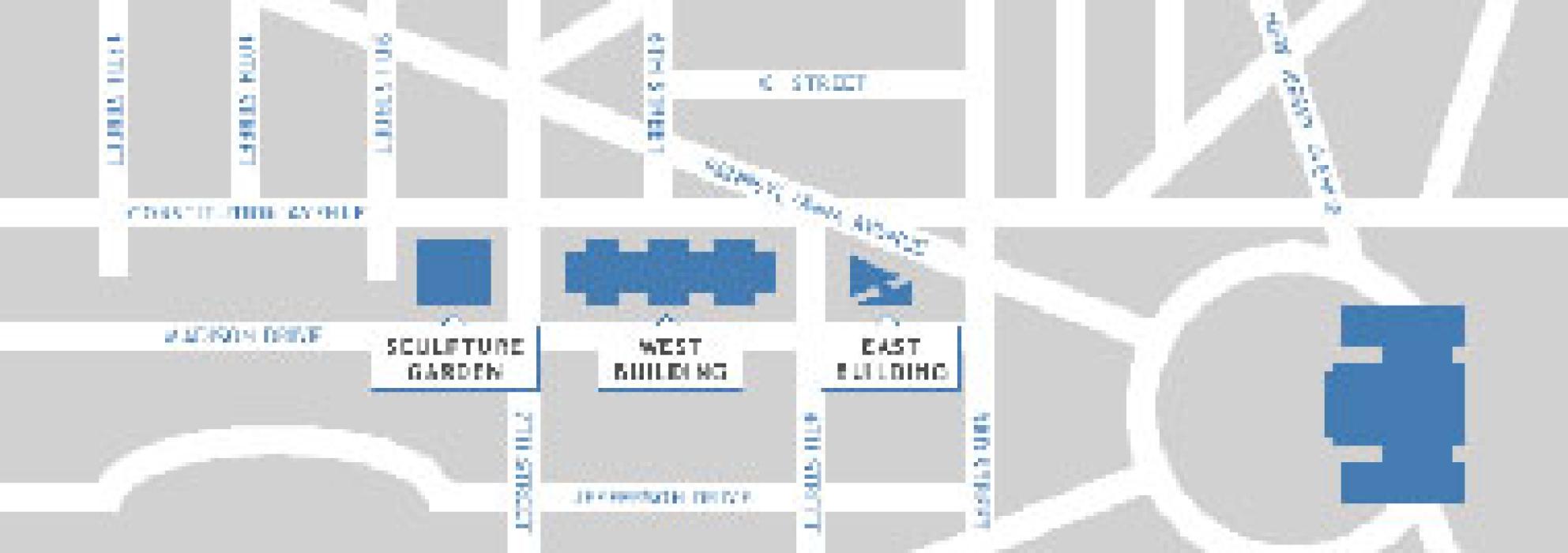
Have students locate the West Building:
- What shape is the site built on?
- Did the site influence the building's design? (You bet! The site is a rectangle, and the building is a huge rectangular solid with a central dome.)
Now have them look at the layout of the streets:
- Which street runs at an angle to the others? (If you said Pennsylvania Avenue, you are correct. It is a broad diagonal that runs from the White House to the Capitol. The inaugural parade—and the new President—travels along Pennsylvania every four years.)
- If you follow your eye down Pennsylvania Avenue, do you see where it slices off the corner of what would have been a rectangular plot of land for the new East wing of the Gallery? (No way planners could reroute this famous avenue to make a more standard—rectangular or square—site for the new Gallery!)
- How did Pei solve this challenge? (Have students hypothesize before completing the worksheet in the next activity.)
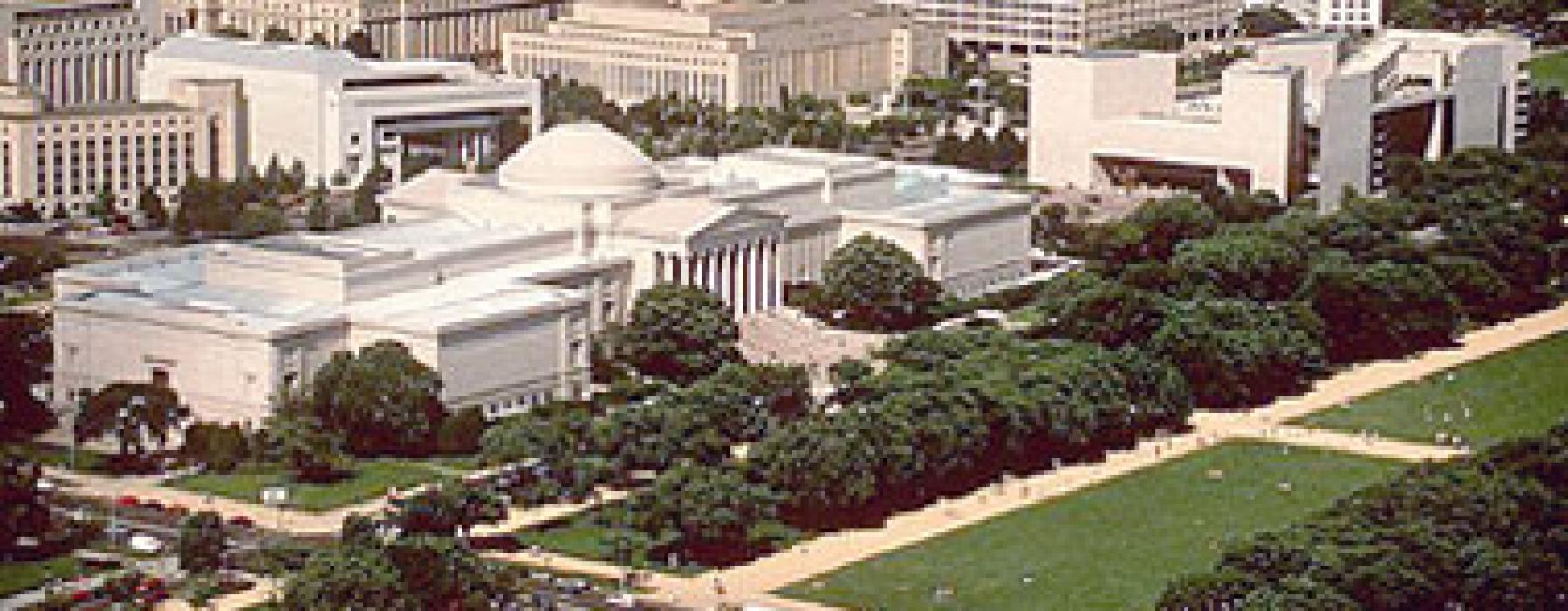
Aerial view of the National Gallery of Art, Washington
© Dennis Brack/Black Star
National Gallery of Art, Gallery Archives
Activity
Pei describes his process:
"I come back to the city . . . it is rather rigidly geometric. You never can separate a building from the place where it's standing."
"A piece of architecture is the embodiment of a combination of factors: time, place and use . . . it is the where, the when and the why that a work must address, convincingly and eloquently and with style. To me that is the heart of architecture."
In the worksheet “Pei’s Polygons,” students will explore how Pei used geometry to meet this challenge and then experiment with ways to divide different polygon floor plans into triangles. Have students use markers or colored pencils to fill in their patterns.
Extension
Ask students to bring in a street map or plan of a town or neighborhood for the next class.
- Begin by reviewing the constraints that Pei faced when beginning the design for the East Building. Look again at the online street map of the area surrounding the Gallery. Discuss the grid plan, the diagonal avenue, and the shapes of the buildings within the grid.
- Bring the discussion home by examining a map of your own city or town. How is it laid out? Anything unusual? Ask students to share street layout on maps they brought to class.
- Talk about the buildings in your city or town. Are there unusual buildings in your area? Have students write the names of local neoclassical and modern buildings.
- Now, have students design their own city plans on graph paper or with "City Creator", an online city building tool.
- Give students one minute to present their city to the class, explaining the layout and their choice of building shapes and architecture.
Download
You may also like

Educational Resource: Horace Pippin's Story, Grade Level: 1–2
Students will learn about the life and painting style of African-American artist Horace Pippin. They will discover how to "read" the clues in his painting School Studies and write a story about the work. By solving counting and time problems, students will also create their own "secret number" painting.



